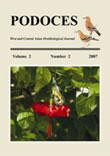فهرست مطالب

Podoces
Volume:2 Issue: 2, 2007
- تاریخ انتشار: 1386/10/11
- تعداد عناوین: 14
-
Page 77This article lists 99 articles on distribution of wild birds in Iran, which appearedbetween 1876 and 1977 and which were published by authors writing in Europeanlanguages. Each paper has a reference number and is supplied with annotations, giving the localities and time of year where the bird observations had been made. These localities are also listed on a separate website (www.wesca.net/podoces/podoces.html), supplied with coordinates and the reference number. With help of these coordinates and the original publications an historical atlas of bird distribution in Iran can be made. A few preliminary examples of such maps are included. Many authors also collected bird specimens in Iran, either to support their identifications or in order to enravel subspecies taxonomy of the birds of Iran. The more important natural history museums containing study specimens from Iran are listed.
-
Page 97The Varjin Protected Area (26,907 ha) is one of the unique landscapes of theAlborz Mountains. The survey was carried out between 2005 and 2007. In 43 days ofsurvey, 100 bird species were observed in various parts of the Protected Area. 25 specieswere new records for the area. As designated in the Department of the Environment (DOE) laws, 5 species are categorised as "Endangered" and 20 as "protected species".
-
Page 106This paper summarizes the distribution of the Barn Owl in Iran since 1990. Approximately 74 birds have been recorded from 28 localities since 1990, whereas there were only three records of the species in Iran in the 1970s (from two localities in Khuzestan Province and one locality in Bushehr Province). It is concluded that there has been a major expansion in the range of the species in Iran in recent decades. This paper also documents the discovery of a pair of Barn Owls nesting at Kapour-Chal, near Anzali, Gilan Province, in northern Iran in the summer of 2007.
-
Page 113Usually, fewer than 2,000 swans of three species, Mute Swan Cygnus olor,Whooper Swan C. cygnus and Bewick’s Swan C. columbianus bewickii, migrate to thewetlands of northern Iran during autumn and winter every year. Most of these birds spend the winter in the wetlands of the south Caspian region and northwestern Iran, in th provinces of Gilan, Mazandaran, Golestan, Ardabil, West Azarbaijan and East Azarbaijan.Numbers of all three species fluctuate widely from year to year, and are dependent on the severity of the weather, with very large numbers of Mute and Whooper Swans arriving in severe winters. This paper examines the mid-winter counts of swans in Iran during the tenyear period 1997–2006, and identifies internationally important sites that have supported more than 1% of the regional populations.
-
Page 122Some feeding and breeding activities of Purple Sunbird Nectarinia asiatica brevirostris have been studied in five localities in Bandar Abbas, southern Iran from June 2002 to June 2004 on monthly bases. According to 507 timed feeding observations, Purple Sunbirds feed on flowers’ nectar (97%) and on fruits’ nectar (3%). The nectar of the Chinese hibiscus Hibiscus rosa-chinensis flowers was the favorite food (56%). Red flowers seem to be attractive. The breeding season is late autumn and early winter, where flowers are abundant and temperate season has begun in the area. Nesting started in November, 2–3 eggs being laid in December and hatching occurring after 15–17 days of incubation. Only the females built nests and incubated eggs, while males assisted in feeding nestlings. Purple Sunbirds used 16 species of plants of which they fed and five species for nesting. The gum acacia tree Acacia nilotica is particularly suitable: it provides cover, is a source of food is ideal for nesting, and so it plays an important role in dispersion of this sunbird species in the area. The kandi tree Prosopis cineraria is also favoured. Purple Sunbird inhabits parks and green spaces of institutes and residential areas in the city of Bandar Abbas.
-
Page 127The breeding range of the Common Swift Apus apus covers large partsof Eurasia from the Atlantic Ocean to the Yellow Sea. Arrival and departure dateswere clearly defined. The phenological dates from different locations wereanalysed and compared. There are only a few dates from most of the locations,while those from places in north and central Europe were numerous. The situationregarding the phenological dates of the different locations is variable. Arrival in thebreeding areas extends from February in Israel to June in the Murmansk area. Itturned out that the first birds seen were the local breeders. The dates presented donot show a consistent pattern. The stay in the whole breeding area seems to be95±3 days. In all sub-areas, however, shorter and longer stays are recorded. Thisarticle discusses whether or not these differences result from locally differingbehaviour of the Common Swift or simply from insufficient data. There areindications that the geographical location as well as the elevation above sea levelinfluences the duration of their stay.
-
Page 160185 questionnaires were distributed to hunters around Gomishan Wetland onWednesdays, Thursdays and Fridays in December 1996 and January–February 1997 (NB:the weekend in Iran is Thursday/Friday). Of the respondents, 68.3% were forty years old or more, 35% were educated to elementary level, 54.1% were farmers, and 44.7% had hunted for more than 10 years. Of only 35.3% of hunters that responded to the question as to why they hunt, 25.9% said they hunted for food and the remainders said that they hunted for sport. 55.8% go hunting in one or two weeks a month, and 34% go hunting on Fridays.56.5% of hunters use their own vehicles, and 36.5% use boats for hunting. For 70.5% ofhunters, the main targets are ducks (Anas spp.), while 29.5% hunt mainly ducks andEurasian Coot Fulica atra. 55.3% shoot fewer than 5 birds per hunting trip and 37.6%shoot 5–10 birds per trip. According to the questionnaires, 26.3% of the birds killed weremostly Eurasian Coots, 18.7% were ducks, and 55.0% were ducks or coots. 66.2% ofrespondents believed that the population of waterbirds has been declining in recent years.

